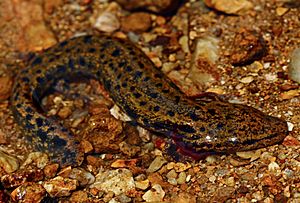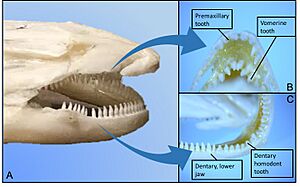Common mudpuppy facts for kids
Quick facts for kids Common mudpuppy |
|
|---|---|
 |
|
| Conservation status | |
| Scientific classification | |
| Genus: |
Necturus
|
| Species: |
maculosus
|
| Synonyms | |
|
Sirena maculosa Rafinesque, 1818 |
|
The common mudpuppy (Necturus maculosus) is a type of salamander. These amazing creatures live their entire lives in water, found in lakes, rivers, and ponds across North America.
Mudpuppies are special because they keep their external gills even as adults. This means they never fully change like many other amphibians. Their gills are super important for breathing underwater, as their skin and lungs alone aren't enough.
They are usually a rusty brown color with dark spots. Mudpuppies can grow quite large, up to about 24 inches long. They are mostly active at night (this is called being nocturnal). You might only see them during the day if the water is very cloudy.
Mudpuppies are not picky eaters! They will eat almost anything they can fit into their mouths. This includes insects, snails and clams, and earthworms. Female mudpuppies start laying eggs when they are about six years old. They can lay around 60 eggs at a time. In the wild, mudpuppies usually live for about 11 years.
Contents
Appearance of the Mudpuppy
Mudpuppies are small, often compared to the size of a lizard. They can be rusty brown with gray and black colors. They usually have blackish-blue spots. Some rare albino mudpuppies have even been seen.
Their skin color can change to match their surroundings. In clear, bright water, their skin gets darker. In darker water, their skin becomes lighter. Adult mudpuppies are usually about 13 inches long, but some have been found up to 17 inches!
Their Special Gills
Their external gills look like fluffy ostrich feathers. The size of these gills depends on how much oxygen is in the water. If the water is still and has less oxygen, mudpuppies will have larger gills to help them breathe. In fast-moving streams with lots of oxygen, their gills are smaller. These gills have many tiny blood vessels, which help them take in oxygen.
Mudpuppies also have small, flat legs. They use these legs to slowly walk along the bottom of streams or ponds. They can also flatten their legs against their bodies for short bursts of swimming. Their skin has special glands that make a slimy coating, which protects them.
Staying Young Forever
Mudpuppies are one of the few salamanders that do not go through a full change (called metamorphosis). Most salamanders change from a water-dwelling larva with gills to a land-dwelling adult without gills. But mudpuppies keep their gills and stay in the water their whole lives. It's like they stay in their "kid" form forever!
Where Mudpuppies Live
Common mudpuppies live in streams, lakes, and ponds across eastern North America. You can find them from southern Canada all the way down to Georgia. They are also found from the Midwest United States to North Carolina.
During the day, mudpuppies like to hide under rocks and logs. They become more active at night. But if the water is very muddy, they might be active during the day too. Mudpuppies are tough! They can even survive under the ice when lakes freeze over in winter. There is also a group of mudpuppies that were introduced to Maine.
What Mudpuppies Eat
Mudpuppies use rows of small, cone-shaped teeth to catch their food. They have teeth on the top and bottom of their mouths. All their teeth are similar in shape, which helps them hold onto slippery prey.
Since mudpuppies always live in water, their teeth are designed to stop prey from escaping. They don't crush their food. When a mudpuppy eats, it uses a "suck and gape" method. This means they quickly open their mouth, suck in water and their prey, and then their teeth hold the prey inside. Their lips lock together at the sides, which helps them create this suction.
Mudpuppies are carnivores, meaning they eat meat. They will eat almost anything they can get into their mouths! Their diet includes insects, snails, worms, small fish, other amphibians, and even spiders.
Mudpuppies don't have many enemies. However, larger fish, crayfish, turtles, and water snakes might try to eat them. Fishermen sometimes catch mudpuppies by accident and then throw them back.
Life Cycle of the Mudpuppy
Mudpuppies need about six years to become old enough to have babies. Mating usually happens in the autumn, but the female doesn't lay her eggs until much later, usually in the spring.
When male mudpuppies are ready to mate, a part of their body called the cloaca swells up. The male leaves small packets of sperm (called spermatophores) on the bottom of the water. The female then picks these up with her cloaca. She stores the sperm inside her body until she is ready to lay her eggs.
Before the eggs are laid, the male mudpuppy leaves the nest. The female finds a safe spot to lay her eggs, often on the underside of a rock or a log. She can lay anywhere from 20 to 200 eggs, but usually around 60. The eggs are not colored and are about 5–6 millimeters wide. The female stays with her eggs for about 40 days until they hatch.
When they hatch, baby mudpuppies are about 2.5 centimeters long. They grow to about 3.6 centimeters before they use up all the food from their yolk sac.
Types of Mudpuppies
There are a few different types, or subspecies, of mudpuppies:
- N. m. louisianensis (Red River mudpuppy)
- N. m. maculosus (common mudpuppy)
- N. m. stictus (Lake Winnebago mudpuppy)
See also
 In Spanish: Perro de agua para niños
In Spanish: Perro de agua para niños



